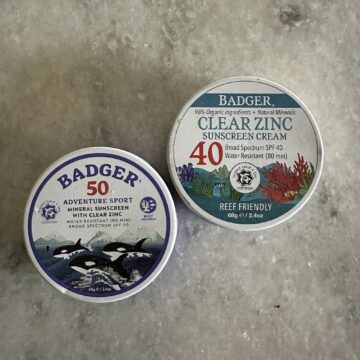There is no nice way to say this. If you’ve been a believer in mineral sunscreen, this will make you scream a little scream. Zinc oxide, previously thought of as the gold standard of human-friendly and eco-friendly sunscreen ingredient, can also damage marine life.
But how is this possible, you may ask, since we’ve only been warned about chemicals? A quick rewind: In January 2021, Hawaii passed a ban on sunscreens containing oxybenzone and octinoxate. These chemical (also called “organic”) ingredients work by being absorbed into your skin and transforming UV rays into infrared heat. They are found in the majority of sunscreens for sale in the U.S. The law passed after a 2016 study found that in Hawaii and the Caribbean, these chemicals were the bigger contributor to coral bleaching than climate change. Many brands and influencers have been espousing mineral sunscreens as a reef-friendly alternative. It was easy to believe that chemicals = bad, minerals = natural and good.
Is zinc oxide bad for the environment?
Zinc oxide can harm coral reefs
Like many environmentalists, I’ve been exclusively sporting mineral sunscreens for about ten years. On a recent trip to the warm Gulf of California, I saw an acquaintance had brought a chemical sunscreen. I offered her the use of my mineral sunscreen, explaining it was better for the reefs. Oh, how I bristled when I saw her reapplying her chemical sunscreen a few hours later! But now I’m humbled to know that in Europe, sunscreens containing zinc oxide require a label that it is harmful to marine life. In fact, numerous studies over the years have shown that zinc oxide “induces a severe and fast coral bleaching due to the alteration of the symbiosis between coral and zooxanthellae.” Marine ecologist Cinzia Corinadelsi said to the Smithsonian: “Unfortunately, despite several cosmetic products and sunscreens available in the market are defined ‘reef-safe’ or ‘eco-friendly’ or ‘biodegradable,’ they are not so, and indeed lack specific tests on marine organisms.”

Titanium dioxide: slightly better
Zinc oxide is one of only two sunscreen ingredients that are “generally recognized as safe and effective” (GRASE) according to the FDA. Interestingly, in the earlier study by Corinadelsi, titanium dioxide (the other GRASE ingredient) has been shown to have no effect on coral bleaching. But did you know that titanium dioxide is a petroleum byproduct? Like plastic, this is something that I’m disconcerted by and can still manage to live with.
Before you throw out your cute zinc oxide sunscreen, here are a couple more points of consideration.
What reef-friendly sunscreen options do we have?
Reef-friendly chemical sunscreens
There are chemical sunscreens that claim to be reef-friendly. A popular example is Supergoop Unseen Sunscreen, which claims its use of “clean chemicals” like Avobenzone, Homosalate, Octisalate, and Octocrylene. This sunscreen touts its invisible absorption, “reef-friendliness,” as well as post-consumer recycled and recyclable packaging. A word of caution: avobenzone and other chemical ingredients are not proven coral-safe. More accurately, these haven’t been proven harmful.
All zinc oxide sunscreens are not the same
Nano zinc oxide is the ingredient that is proven to damage coral. Nano means microscopic particles that have been developed to increase performance. Think of them as particles so small that they can enter the bloodstream when ingested. Regular zinc oxide is considered safer for the environment. How can you tell the difference? Simple: nano zinc oxide will absorb invisibly like chemical sunscreens, and zinc oxide will sit on top of your skin and be visibly white.
Zinc oxide has many skin benefits
It is the only sunscreen ingredient that provides UVA1, UVA2, and all the UVB ray blocking benefits, beating out even titanium dioxide. Zinc oxide has also a long history of use as topical medicine against inflammation, rash, and even acne.

What I’ll be doing as a concerned ocean lover
Experts agree that the only truly reef-friendly sun protection is clothing. Around 6,000–14,000 tons of sunscreen are released into the oceans each year. Whether it’s made of minerals, petroleum byproducts, or chemicals, that will have an impact on ecosystems. Even soil wouldn’t be good in that amount, and that’s completely biodegradable. Unfortunately, expecting people to wear long-sleeve everything and a wide-brimmed hat while enjoying a warm beach is unreasonable. It doesn’t take into account human nature, which ultimately doesn’t work even for best-intentioned people.
For me, the difference between nano and regular zinc oxide—and the reassuringly thick, pasty application of my Badger sunscreen—are enough to convince me to keep it. I’m less convinced that chemical sunscreens can truly be reef-safe, thus labeled or not. But this doesn’t mean I’ll go hog wild with my zinc oxide sunscreen, either. It makes me think again about human impact especially when it’s concentrated in a small area. Complementing your sunscreen with umbrellas, hats, and clothing can definitely cut down on the amount of ingredients seeping into the oceans. [Translation: unless I’m swimming, you’ll see me covered up in the shade.]
Get more like this—Sign up for our daily inspirational newsletter for exclusive content!
__
Photo: Peaceful Dumpling; Spencer Davis via Unsplash




